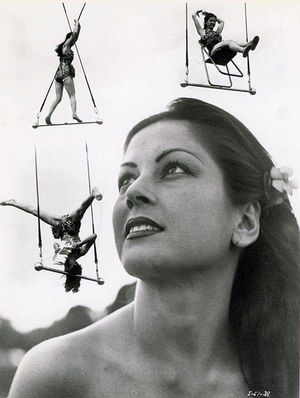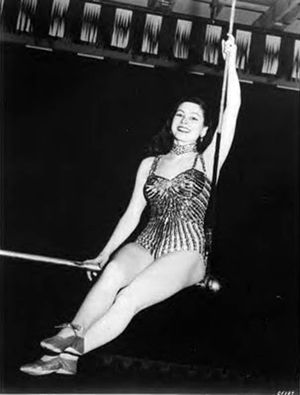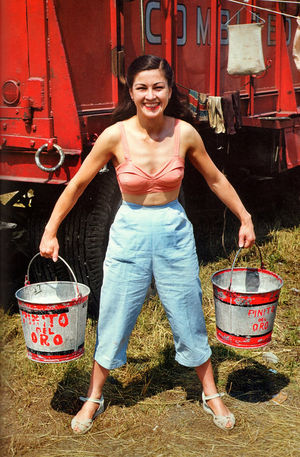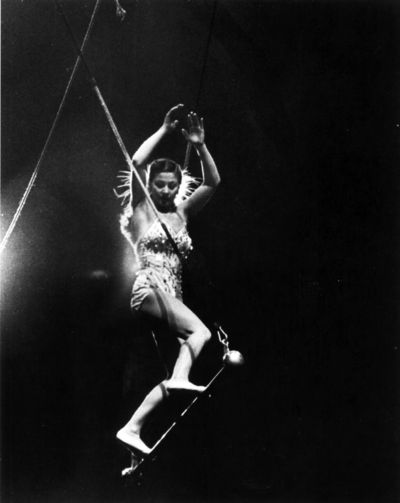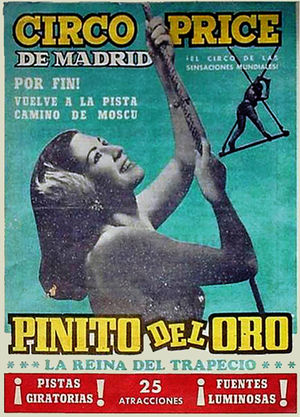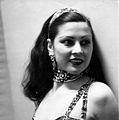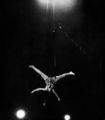Pinito del Oro
From Circopedia
Aerialist
By Dominique Jando
Pinito del Oro (1931-2017) was a genuine circus star, an iconic personality of the Spanish entertainment scene, and one of the world’s top aerialists in the 1950s and 1960s. Beautiful, with a natural elegance and a radiant smile—and indeed extremely talented—she was featured with her outstanding Washington trapeze(orig.: "trapèze à la Washington" – French) A heavy trapeze with a flat bar, on which an aerialist performs balancing tricks. Originated by the American aerialist H. R. Keyes Washington (1838-1882). act in Europe’s most prestigious circuses, and had been a center-ring headliner with Ringling Bros. and Barnum & Bailey Circus in the United States for seven consecutive seasons. She was also courageous and resilient: she survived three near-fatal accidents, and each time resumed her precarious career on the trapeze.
The Segura Family
She was born Cristina María del Pino Segura on November 6, 1931 in Las Palmas de Gran Canaria (on Gran Canaria, one of Spain’s Canary Islands off the coast of southern Morocco). Spain was in political turmoil at the time, entering a period of disorder that would lead to the Spanish Civil War, and Pinito’s father, José Segura, had decided to take his small family circus company to the Canary Islands, far from the mainland’s troubles, and in an area also totally devoid of competition. (The Spanish circus scene at the time was particularly active.)
José Segura was not born into the circus: He came from a middle-class family of Alcoy, in the Province of Alicante (southeast of Spain), where his parents ran a delicatessen. They wanted José to be a doctor, but alas, José’s father died unexpectedly, and there was no money left to pay for his studies. One of José’s uncles stepped in—but he wanted José to enter a seminary and embrace priesthood. This didn’t suit José’s bohemian lifestyle and his taste for pretty girls; he ran away from home and joined a traveling comedian and puppeteer named Anastasiano, who initiated him to the performing arts and taught him rudiments of acrobatics, juggling and other circus skills.
José Segura had found his true calling. He became a circus performer—a jack-of-all-trades working indiscriminately as a clownGeneric term for all clowns and augustes. '''Specific:''' In Europe, the elegant, whiteface character who plays the role of the straight man to the Auguste in a clown team., a perch-poleLong perch held vertically on a performer's shoulder or forehead, on the top of which an acrobat executes various balancing figures. artist and a flying-trapeze catcherIn an acrobatic or a flying act, the person whose role is to catch acrobats that have been propelled in the air.—and married Atila Gómez, who came from a circus family. Atila gave him nineteen children—only seven of whom survived. All the Segura children worked in the small circus show their father had formed, and they originated an exceptionally talented circus dynasty—producing such remarkable artists as the aerialistAny acrobat working above the ring on an aerial equipment such as trapeze, Roman Rings, Spanish web, etc. Carmen del Teide, the tight-wire somersaulter Atilina Segura, and the bouncing-rope acrobat Arturo Segura, all of whom were Pinito del Oro’s nieces and nephew.
Cristina was the youngest and the last of Atila’s children. Her second name, María del Pino, was that of "la Virgen del Pino" ("The Virgin of the Pine Tree")—the Virgin Mary, who was said to have appeared in Las Palmas in a pine tree, and became the protector of the city. Her family nicknamed Cristina "Pinito," Spanish for "Little Pine Tree." (Her stage name, "del Oro," which was bestowed upon her by her father, apparently refers to Las Palmas’ golden sand dunes.)
Pinito’s mother, who had lost so many children in infancy, kept her last daughter in a cocoon and didn’t want her to perform. Pinito was under her constant attention and protection. Like all traveling circus children of the time, she had a sketchy formal education; she attended a number of local schools, each time for a short period, following the family’s travels. Yet she was intelligent and curious, and she quickly developed a passion for reading, something her mother strongly encouraged.
Pinito thus became a well read woman; she had a strong imagination and later began to write for herself—a hobby that would eventually lead her to publish several books. She was a pretty child, albeit tiny and of delicate appearance; her brothers made fun of her, and nicknamed their pampered little sister Shirley Temple—a scorn Pinito still resented in her later years. She had an intellectual bent, and she did not match very well with her highly physical and overworked siblings.
From Tight Wire to Trapeze
Delicate or not, came a time when her father decided that Pinito should contribute to the Segura family show. She was nine years old, and furthermore, she had limited physical skills. José may have noted, however, that his odd daughter had a good sense of balance: He put her on the tight wireA tight, light metallic cable, placed between two platforms not very far from the ground, on which a wire dancer perform dance steps, and acrobatic exercises such as somersaults. (Also: Low Wire). Pinito hated it. She became very self-conscious and was ashamed to perform in front of an audience: She thought her act was not good. But she was not given a choice.
Thus Pinito del Oro, the circus performer, was born. Not the star aerialistAny acrobat working above the ring on an aerial equipment such as trapeze, Roman Rings, Spanish web, etc., though: The family star aerialistAny acrobat working above the ring on an aerial equipment such as trapeze, Roman Rings, Spanish web, etc., then, was her elder sister, Esther, who had a trapeze act. A few years later, while they were back touring in mainland Spain, one of the circus trucks overturned on a slippery road between Cadiz and Seville, where the Seguras were scheduled to perform at the Feria. Esther was killed in the crash. "The show must go on" may seem a corny cliché, but nowhere does it carry more actuality than in the circus: Pinito had to take her sister’s place as the show aerialistAny acrobat working above the ring on an aerial equipment such as trapeze, Roman Rings, Spanish web, etc.. This was 1943, and she was twelve years old.The Washington trapeze(orig.: "trapèze à la Washington" – French) A heavy trapeze with a flat bar, on which an aerialist performs balancing tricks. Originated by the American aerialist H. R. Keyes Washington (1838-1882). (a trapeze with a heavy, flattened bar on which the artist performs balancing tricks) was an obvious apparatus for Pinito: She was not that strong as an acrobat, but she was a good balancer, and could therefore transfer her skills from the tight wireA tight, light metallic cable, placed between two platforms not very far from the ground, on which a wire dancer perform dance steps, and acrobatic exercises such as somersaults. (Also: Low Wire) to the trapeze. Atila, who didn’t want Pinito to become a circus artist, never saw her daughter perform on the apparatus that would make her famous: She suffered from hyperglycemia, and sadly, she died just before Pinito’s debut.
It was indeed a very difficult debut, emotionally, for Pinito. But if anything, she was courageous and tough. Now left to her own devices, the pretty young girl on the swinging trapeze developed into a superb artist with a breathtaking act. Balancing on a narrow swinging bar hanging up in the air is an act that can be nerve-racking to watch; it is perhaps a good thing that her protective mother never saw Pinito perform her perilous trapeze maneuvers.
From H. R. Keyes Washington (1838-1882), the creator of the genre, to his later emulators, Washington trapeze(orig.: "trapèze à la Washington" – French) A heavy trapeze with a flat bar, on which an aerialist performs balancing tricks. Originated by the American aerialist H. R. Keyes Washington (1838-1882). had long been presented as a bravado act, emphasizing a sense of imminent danger overcome by triumphant macho daredevils. Pinito del Oro indeed played this suggestion of danger (all-too-real since she was performing without any sort of safety device), but she did so with extraordinary grace, and with a natural, childlike vulnerability that made it impossible for the audience to take their eyes away from her. Although she did all what the male practitioners of the specialty did, and even more, she remained exquisitely feminine and never lost her innate appearance of fragility—a combination that made her unique.
And danger there was: She had her first accident in 1948, during a performance in Huelva, in the south of Spain. She fell from her trapeze and suffered a skull fracture that left her eight days in a coma. But she recovered, and went back to perform her act. She was by now making a name for herself, and for the 1949 Christmas season, she performed in Valencia with Circo Hermanos Diaz. There she was spotted by one of John Ringling North’s talent scouts, who offered her a contract in the United States with Ringling Bros. and Barnum & Bailey Circus, The Greatest Show On Earth.
International Circus Star
Pinito was eighteen years old and, as a minor, she couldn’t travel alone. She quickly married one of her suitors, Juan de la Fuente, a former sailor, who was given a crash course in aerial rigging in order to become her assistant. The newlywed couple arrived in Sarasota, Florida, the winter home of the Ringling circus, in time for the long and intricate rehearsals preceding the show’s grand opening at Madison Square Garden, in New York City.
Pinito immediately loved America. She had come from a country that was now stuck in the gloom of Franco’s dictatorship—and although circus was extremely popular in Spain, Francisco Franco was only interested in bullfights and soccer, which didn’t make him especially appealing to circus folks. In the New World, Pinito saw her first washing machine, her first pack of Kleenex. As she later remarked, she had left black-and-white Spain for Technicolor America! She had other reasons to be happy: She was immediately put above the center ring, as the focal point of a lavish aerial display.On April 5, 1950, Pinito del Oro made her American debut at Madison Square Garden in an aerial spectacle heralded as "The Indescribably Stunning New Extravaganza in the Air, Seville", which was introducing "Beautiful Pinito Del Oro, Spain's Lovely Star of the Swinging Trapeze. First Time in America." On the side rings were aerialists Bobby Dubreuil and Elsie Davis, surrounded by an "Exquisite Ballet of Sixty Alluring Senoritas Aloft." Pinito was now in another world altogether—and she was a star act in The Greatest Show On Earth!
During the winter, she followed Ringling Bros. and Barnum & Bailey for a special series of performances in Cuba, before returning to Sarasota to prepare the 1951 season. She was this time the only featured aerialistAny acrobat working above the ring on an aerial equipment such as trapeze, Roman Rings, Spanish web, etc. in another "Enchanting Ethereal Extravaganza" titled Luawana. The printed program described it as a "Heavenly Hawaiian Hula." Pinito was "Riding Tiptoe on a Moonbeam with a Ballet of Sixty Alluring Aloha Girls Aloft."
This sumptuous aerial tableau can be seen in Cecil B. DeMille’s movie, The Greatest Show On Earth (1952); onscreen, Dorothy Lamour sings its theme song, Lovely Luawana Lady, whose music was composed by John Ringling North. But Pinito is nowhere to be seen: She refused to appear in the movie without a screen credit. (Yet, many circus chroniclers have stated erroneously that she had been featured in DeMille’s Oscar-winning epic.) John Ringling North's 1951 production also offered a three-ring display of aerialists: Lilo Juston, La Norma, and Pinito’s compatriot and close friend, Miss Mara, who made her American debut that season with the Ringling show.
Pinito’s contract with Ringling Bros. kept being renewed, and she continued to be a center-ring feature in lavish aerial ballets, the musical scores of which were signed by John Ringling North. In the winter, she played dates with Polack Bros. Circus, a leading Shrine Circus producer with a reputation for quality and excellence. For the 1952 Holiday season, she was featured in Tom Arnold’s Mammoth Christmas Circus at the Harringay Arena in London—one of Europe’s most prestigious winter circus shows. In 1955, she must have felt en famille: Her niece, the very talented somersaulter on the tight wireA tight, light metallic cable, placed between two platforms not very far from the ground, on which a wire dancer perform dance steps, and acrobatic exercises such as somersaults. (Also: Low Wire) Atilina Segura, was on the Ringling show, along with Pinito’s friend, Miss Mara, and Mara’s brother, Tonito, another exceptionally brilliant tight-wire artist.
Pinito’s last appearance with The Greatest Show On Earth was in its fateful 1956 production, in which she was featured in yet another aerial extravaganza titled Mexicanorama. This time, John Ringling North didn’t bother to write the music. As it was, the giant traveling circus had become unmanageable, plagued with union problems and ever-increasing operational costs. On July 16, 1956, in Pittsburgh, Pennsylvania, only three and a half months after its Madison Square Garden opening, "the Big One," as the Ringling show was known in the business, folded its tents for the last time. John Ringling North announced to the press: "The tented circus as it exists today is, in my opinion, a thing of the past." To many, this marked the end of an era—and so it was for Pinito; she returned to Spain.
Back to Europe
In spite of General Franco’s lack of interest for the performing arts, the Spanish circus enjoyed its zenith in popularity and quality from the late 1950s to the early 1970s—in fact during most of Franco’s dictatorial reign. (History has shown time and again that the circus, which is not deemed politically dangerous and thus is not subject to artistic censorship, always finds a comfortable niche for itself under authoritarian regimes.) Great Spanish performers could be seen all over Europe and were featured in the world’s best circus and variety shows—Pinito among them—and Spanish circuses were flourishing. Circus impresarios such as Juan Carcellé, Manuel Feijóo and Arturo Castilla were powers to reckon with, and Spanish audiences had become circus savvy.Pinito del Oro had returned to her home country at the right time. She had been invited to participate in the Gran Competición Mundial del Circo, organized in November 1956 at Barcelona’s Palacio Municipal de los Deportes (a sport arena) by Arturo Castilla, in association with Juan Carcellé and Pedro Balañá. Pinito was proclaimed "Reina del Festival" (Festival’s Queen), and many European agents and directors—a large number of whom had never seen her perform until then—began to court her.
Juan Carcellé had also offered Pinito a contract to work at the illustrious Circo Price, on the Plaza del Rey in Madrid, which he managed at the time. The appearance of the beautiful and gifted American-made star on the fabled Madrilenian ring was an unmitigated triumph. Pinito’s talent may have blossomed out of her country, but the Spanish audiences instantly reclaimed her, and Pinito del Oro became a household name in Spain. She was subsequently featured at the Coliseu dos Recreios in Lisbon, Portugal—another prestigious European venue at the time. Her European career was launched.
In 1957, Pinito toured in Sweden with Cirkus Scott, that country’s premier circus. On April 29, in Stockholm, she suffered again a very bad fall that sent her to the hospital with another skull fracture, and several fractures to her hands and feet. After a quick but intensive period of rehabilitation, during which she also wrote her first book, Cuentos del Circo, the ever-resilient Pinito was back to her trapeze. She spent the 1957-1958 Holiday season at the Deutschlandhalle in Berlin. In September and October 1958, she appeared at Paris’s Cirque Medrano, where the knowledgeable Parisian press praised her without restraint, and Parisian audiences flocked to the legendary circus to see her.
Then, for the 1959 season, she returned to the United States to perform with Clyde Beatty-Cole Bros. Circus, which had taken the place of Ringling Bros. and Barnum & Bailey as the world’s largest tenting circus (Ringling was now playing sports arenas) and featured America’s biggest circus star at the time, Clyde Beatty. A journalist from St. Petersburg, Florida, noted: "Almost rivaling Clyde Beatty, who battles a full cage of lions and tigers, is Pinito del Oro, Spain’s lovely 'Goddess of balanced flight.'" As a matter of fact, the beautiful Pinito was the true star of the show to a large section of the audience, male in particular.
The Final Stretch
This American tour had a purpose: Pinito needed extra money, preferably in good U.S. dollars. She had long dreamed of opening a hotel on the Canary Islands in Las Palmas and retire there—which she was finally able to do soon after she returned home. To many circus enthusiasts, however, this was disappointing news. One of them was Arturo Castilla, who had taken over Madrid’s Circo Price in 1960 with his business partner, Manuel Feijóo. They had refurbished the Madrilenian circus to its former glory, and Castilla—a genuine circus aficionado—wanted all the greatest names in the circus world to appear in the circus of the Plaza del Rey under his management. He began to cajole Pinito into returning to the ring.
Castilla eventually found a breach in Pinito’s resistance when he invited her to participate in a tribute to her niece, Carmen del Teide, staged at Circo Price in December 1966. Pinito had only to present an award to Carmen, but when she entered the ring, the house went berserk; they were chanting her name, and what was originally Carmen’s meticulously staged tribute became a spontaneous and wild audience’s tribute to Pinito del Oro. Needless to say, Pinito was quite shaken, and all what Arturo Castilla had to do then was to use his charm, which he had in ample supply, and finish the job.After a six-year hiatus, Pinito del Oro made her triumphant return to the ring on March 2, 1967 at Circo Price. It had taken her only two months to get back in shape. The next day, the Madrilenian newspaper ABC waxed poetic: "Pinito was as beautiful as before, in her tight gold maillot under her sparkling cape, standing like a goddess—or would it be better to say like a dove?—on the silver bar enveloped by the stare of a thrilled audience whose hearts were thumping. In a few nights, perhaps this very night, Pinito’s dance under the cupola of Circo Price will revert once again to the marble statue of a Goddess, and not a dove, but the beauty of this rebirth is the courage and serenity offered to those who were lucky enough to witness their triumphant representation."
She then joined the spring and summer tour of Circo Price’s traveling version. On August 21, 1967, in Laredo in the north of Spain, Pinito was again victim of a fall when, at the end of her act, the attachment of the rope she used to climb down broke. In spite of multiple fractures, she was walking again forty days later. Her career was not over yet! It would have to wait until word of a possible demolition of Circo Price in Madrid began to spread. Then, Pinito announced that if the legendary circus closed, her career would end with it. And so it did: She was part of the stellar cast of Circo Price’s ultimate program, and she gave her last performance on April 12, 1970, which was also the old Circo Price’s final performance.
After that, like a matador, Pinito cut off her ponytail. She retired in Las Palmas, where she transformed her house into a small circus museum. She had one daughter with her husband, Juan de la Fuente—whom she had divorced after twenty years of common life and career. She remarried with a man twenty years her junior, with whom she had another daughter. Every now and then, Pinito del Oro reappeared in public for special circus occasions—often in company of her good friend, Miss Mara. In 1990, she was awarded the Premio Nacional del Circo by the Spanish government, and in 1998, she received the Medalla de Oro de las Bellas Artes for her remarkable contribution to the Spanish circus arts. Pinito del Oro passed away on October 23, 2017 in Las Palmas. She was one of the most iconic stars of the Washington trapeze(orig.: "trapèze à la Washington" – French) A heavy trapeze with a flat bar, on which an aerialist performs balancing tricks. Originated by the American aerialist H. R. Keyes Washington (1838-1882)., on one of the greatest aerialists of the twentieth century.
See Also
- Video: Pinito del Oro, Washington trapeze, a Madrid's old Circo Price (1956)
- Video: Pinito del Oro, interview, at Madrid's old Circo Price (1970)
Suggested Reading
- Pinito del Oro, Cuentos del Circo (Madrid, Editorial Reus, 1957)
- Pinito del Oro, Trapecio: Conocimiento y Tecnica (Madrid, Editorial Reus, 1967)
- Jordi Elias, Pinito del Oro: Una vida en el trapecio (Barcelona, Ediciones C.I.R.C., 1968)
- Pinito del Oro, Nacida para el Circo (Valencia, Prometeo, 1971)
- Cristina Segura (Pinito del Oro), La Víspera (Madrid, Editorial Gráficas Espejo, 1974)
- Pinito del Oro, Circus Love Story — Biografía novelada de Lillian Leitzel y Alfredo Codona ((Madrid, Ediciones Javier Sáinz Moreno, 2010)
- Pinito del Oro, Memorias de una trapecista (Madrid, PPU - Promociones y Publicaciones Universitarias, 2012) — ISBN 9788447710980
